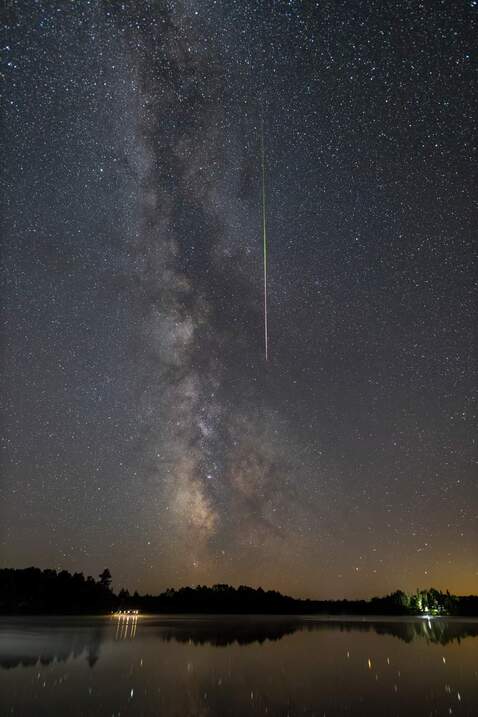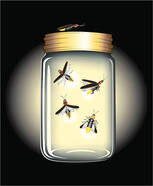Northwoods LIGHTS OUT! Event
Did you know. . .
that 80% of Americans cannot see the Milky Way; 35% of
outdoor light is wasted, costing about 3 billion dollars to literally
be lost to space; and fireflies, hummingbirds, monarch butterflies, and owls are some of the animals most affected by light pollution?
For more click the button below.
that 80% of Americans cannot see the Milky Way; 35% of
outdoor light is wasted, costing about 3 billion dollars to literally
be lost to space; and fireflies, hummingbirds, monarch butterflies, and owls are some of the animals most affected by light pollution?
For more click the button below.
Artificial light can interrupt natural body rhythms in both humans and animals. An increased amount of light at night can lower melatonin production resulting in sleep deprivation, fatigue, headaches, stress, anxiety and other problems. Studies also show that light pollution can influence animal behaviors like migration patterns, wake-sleep habits, and habitat formation. Because of light pollution, sea turtles and birds guided by moonlight can become confused, lose their way and die.
You Can Preserve the Northwoods Night Sky
|
Light pollution is just one of the many reasons our insects are on the decline. You can read more about it at this link:
https://www.oclw.org/insect-decline.html. Unless otherwise stated, all photos displayed on this page were taken by Michele Sadauskas, County Conservationist.
|
What do you see
when you look up at the night sky?
Watch the Fireflies
|
Firefly Conservation
https://www.xerces.org/node/819 When was the last time you
went out to enjoy the fireflies? |
Don't Dim the Light of the Stars
On Friday, June 3, 2022, "Don't Dim the Light of the Stars: The Negative Effects of Light Pollution, was presented by Mary Beth Kiczenski, Noted Nighttime Photographer.
Link to the International Dark Sky Association website below for tips and hints to reduce light pollution in your neighborhood.
A PDF of the presentation only is just below on the green button "PRESENTATION".
Link to the International Dark Sky Association website below for tips and hints to reduce light pollution in your neighborhood.
A PDF of the presentation only is just below on the green button "PRESENTATION".
In addition to the presentation, Mary Beth presented at the North Central Land and Water Conservation Association Spring Meeting. The entire meeting is on YouTube at the following location. (https://youtu.be/NncUwvxDVnE) If you just want to watch and listen to Mary Beth's presentation, start the video at the 2:40:00 mark with an introduction from Michele Sadauskas, Oneida County Conservationist and Baerbel Ehrig, Oneida County Lakeshore Restoration Specialist & Pollinator Coordinator.
Bats and Lighting
Light pollution has been a pretty hot topic for bat research in Europe for some time. Some of the effects appear to be from intensity of light rather than color. Read about light intensity by clicking on the "Intensity of Light" button below.
A study used a before-and-after design where they set up acoustic detectors on the lamp posts for a week prior to replacement and then a week after replacement of the bulbs. Check it out and click on the "Study" button below.
In addition, below is a "Paper" on the effects of light color on bat activity. It mentions how they also measured insect activity, which is a great idea. There are some species like big brown and eastern red bats that will regularly feed on insects (particularly Lepidopteran) near certain streetlights while there are other species like little brown bats who steer clear of these lit-up environments.
A study used a before-and-after design where they set up acoustic detectors on the lamp posts for a week prior to replacement and then a week after replacement of the bulbs. Check it out and click on the "Study" button below.
In addition, below is a "Paper" on the effects of light color on bat activity. It mentions how they also measured insect activity, which is a great idea. There are some species like big brown and eastern red bats that will regularly feed on insects (particularly Lepidopteran) near certain streetlights while there are other species like little brown bats who steer clear of these lit-up environments.
Be Aware of Your Outdoor Lighting
Insect populations, a primary source of food for birds and other animals are drawn to artificial lights and instantly killed upon contact.
Safety-related dangers that come with poor visibility at night are caused by glaring lights or bad lighting design, which allows artificial light to shine outward and upward into the sky, where it is wasted instead of focusing light downward, where it does the most good. There are simple measures we can take to make our use of nighttime lighting most effective.
Safety-related dangers that come with poor visibility at night are caused by glaring lights or bad lighting design, which allows artificial light to shine outward and upward into the sky, where it is wasted instead of focusing light downward, where it does the most good. There are simple measures we can take to make our use of nighttime lighting most effective.
|
For a larger view,
click on the picture above. |
Resources:
Read more about our dark skies or follow the blog from local author, stargazer and dark sky advocate, Ted Rulseh, the Lake Guy at the following link: https://www.thelakeguy.net/darkness-at-night-what-a-concept-the-case-against-dusk-to-dawn-outdoor-lighting/






